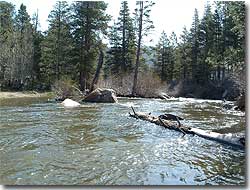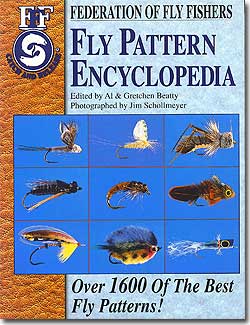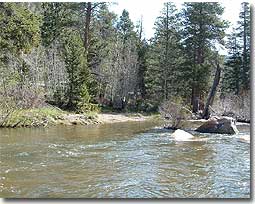Dan Fallon's July Fly Fishing Column
Dan Fallon's July Fly Fishing Column
By Dan Fallon
STREAMER TREATISE 101
 Now that the unwashed hordes who sit at tidy desks sixty hours a week are gathering and flailing America’s beloved wild trout waters armed with carefully purchased deep diving nymphs and assorted dry flies. One can be certain many of our once or twice a year brother, sister fly fishers will encounter many instances when those nicely tied flies are completely useless in the face of either over educated roadside fish or fast water conditions which are now almost everywhere in North America. This fact is elemental and one need not be a detective to understand and become a more polished fly fisher with options, Sir Arthur Conan Doyle 1859-1930 closed this argument nicely, ”Mediocrity knows nothing higher than itself, but talent instantly recognizes genius!”
Now that the unwashed hordes who sit at tidy desks sixty hours a week are gathering and flailing America’s beloved wild trout waters armed with carefully purchased deep diving nymphs and assorted dry flies. One can be certain many of our once or twice a year brother, sister fly fishers will encounter many instances when those nicely tied flies are completely useless in the face of either over educated roadside fish or fast water conditions which are now almost everywhere in North America. This fact is elemental and one need not be a detective to understand and become a more polished fly fisher with options, Sir Arthur Conan Doyle 1859-1930 closed this argument nicely, ”Mediocrity knows nothing higher than itself, but talent instantly recognizes genius!”
Only one riddle exists that if mastered or at least understood will give you the best odds of fooling any picky bored resident trout. Streamers and a host of different streamer feather clad flies work consistently if worked correctly. Before I get into my keys to using these often over looked alternate flies, many terrestrial replica type patterns depicting everything from frogs, snakes, butterflies, worms, lizards, grasshoppers, and others exist and are used by savvy fly fishers who are looking for an edge and a second plan if all else fails! Many serious fly fishers spend a great deal of time seeking out that special butt ugly red and black beetle looking thang that NEVER fails... Every region world wide has that special can’t fail pattern or two local guides cherish more than three days guiding Paris Hilton at a nude fly fishing resort?
Magic bullet type flies do exist and I know of maybe 200 secret patterns I swore to never divulge period, the men and woman who created these never fails covet them like five thousand dollar bottles of Stags Leap Private Estate 1983.One of my personal most used emergency never fails is the Woolly Bugger. These popular streamers mimic eels, small bait fish or simply young fry moving quickly, they can be found almost everywhere and come in many sizes, colors. Though I have seen huge trout and bass hit the frog and snake look alikes, it does not appeal to my comfort level as these replicas seem to cross the line into bass fishing and leave the land of delicate feather fly fisher far behind. Grasshoppers ( usually tied with feathers ) can be deadly either by themselves or used as a top water floater with a tiny nymph tied to the hook and dropped three feet or more, a great searching pattern when one comes upon new waters. Beetles, spiders, bee’s, locusts, lady bugs, are also used by creative fly fishers looking for alternatives.
Many flies called Marabou are effective as are the patterns created to look like baitfish and are constructed of feathers not plastic or metal or any other substance but natural feathers.
Most of the feathered marabou, matuka , sculpin, type flies work so well because the feathers move and imitate breathing fish that look natural in the water when moved at medium to fast speeds. One of the keys to working these flies is to learn to simulate the moves of a natural bait fish, one must simply sit and watch how these little fish move and dart around. Jerking, fast darting moves work best with these flies, if they are worked too slowly fish can easily see they are fake and not hit them. In the real make a mistake and die world of young fry and bait fish, quick jerking movements are a means of avoiding being eaten...
 Many of the more popular streamer flies mentioned come in endless variations and color schemes ranging from dark brown, black, yellow, white, red. I will mention several of my own favorite patterns and the fly tier, if the subject interests you I highly recommend buying a copy of the Federation of Fly Fishers, “ Fly Pattern Encyclopedia” written by Al & Gretchen Beatty, photographed by Jim Schollmeyer, published by Frank Amato Publications Portland Oregon, ( 503)-653-8108.
Many of the more popular streamer flies mentioned come in endless variations and color schemes ranging from dark brown, black, yellow, white, red. I will mention several of my own favorite patterns and the fly tier, if the subject interests you I highly recommend buying a copy of the Federation of Fly Fishers, “ Fly Pattern Encyclopedia” written by Al & Gretchen Beatty, photographed by Jim Schollmeyer, published by Frank Amato Publications Portland Oregon, ( 503)-653-8108.
A fly named “ Baby Sculpin “ tied by Al Beatty is almost perfect with out too much gold or flash, a quite natural moving sculpin. Almost any fly tied by one of my favorite up and comers Jason Aki, this guy is gifted and dedicated! “ Mad Tom Matuka “ tied by Floyd Franke, an all business no frills fish catcher for sure. “ Midnight Leech “ tied by Chuck Collins, a real deal fish fooler for certain, just a taste of color a fine fly.” Blue Electric “ tied by Kurt Zelazny, black marabu and blue flashabou, this fly works very well. “ Royal Lady Woolly Bugger “ tied by Ruth J. Zinck, love this fly with white palmered hackle, well tied and it catches trout for sure! “ Woolly Pup “ Tied by Bud Heintz is deadly with bright red eyes, it will catch trout. One of my latest favorites “ Streaker Sculpin “ tied by Mark Hoeser looks like and swims like a baby trout. Three woman I know of are masters of fly tying by evidence of their unique patterns; Gale Doudy is one of the new masters with her “ Black Gnat “ and “ Black Two Way “ flies. My dear friend Karen Grahm ties a mean set of Eastern classics like the “ Quill Gordon “ and the “ Hendrickson “. Pudge Kleinkuff up in Alaska is a known expert tier of all brands of salmon flies . Who can ever forget Gretchen Beatty’s neon “ Gunnison Trude “ loud but never rude. If a few of these names are not ringing bells I advise buying either the book mentioned above or spending time on the internet because these fly tiers are all expert and worthy of appreciation. Of course my two friends Jay Fair and A.K. Best have been known to spend a little time at the feather covered table now and again as well as Cliff ( 100 Proof ) Sullivan... Let us bow our heads in reverence least we forget the most famous living fly tier of them all Fletcher Quill, hail to the chief!
STREAMER STRATEGY
If you are having difficulty understanding the most effective way to present or work streamers in a variety of water situations, perhaps my philosophy may illuminate your learning curve. The ability of all streamers to successfully twitch and dart as if they are live small bait fish is the key to their success. If you focus on that one guiding principle and set up your leader, tippet according to the clarity, depth, speed, of the water and your casting distance and position. The following example of how I rig and work my favorite # 16 Wooly Bugger in medium to fast water is a good beginning for anyone new to working streamers.
I usually first tie 6/9 foot leaders using never stronger then 3 pound strength when chasing small stream early season trout. My tippet is either #7 or #6 weight tippet with a strength rating of around 3 pounds. I like at least 4/5 feet of tippet and usually paint the streamer hooks black and also black out any shiny metal if they are tied by other people, solid black patterns work best. It seems when I have used this pattern with eyes the catch rate doubles? It might serve you well to learn to use the more invisable #7 weight tippit as it allows more hits because it is less visable, though the lighter tippits require you to be more careful and let fish play longer or risk breaking the lighter tippit.
 First and foremost in understanding how to work or present streamers has to begin with your approach to a stream or river. I have one simple habit to share that has served me well. Fly Fishers who move very slowly and stop and watch for long periods before getting near the waters edge are always more successful. If you practice observation from afar and wait until you see trout rising or moving or feeding? If you wait and become aware of the speed and kind of currents and boulders and under water structure, your chance of hooking a trout in the first or second cast will be far greater. Fly fishers must learn to move slowly, not cast shadows on the water, not crash through brush and knock leaves into water and disrupt the peace and quite, preserve the natural order! It is when you disturb the natural order, all resident trout hide and will not feed no matter if they are wild or hatchery, your day is finished.
First and foremost in understanding how to work or present streamers has to begin with your approach to a stream or river. I have one simple habit to share that has served me well. Fly Fishers who move very slowly and stop and watch for long periods before getting near the waters edge are always more successful. If you practice observation from afar and wait until you see trout rising or moving or feeding? If you wait and become aware of the speed and kind of currents and boulders and under water structure, your chance of hooking a trout in the first or second cast will be far greater. Fly fishers must learn to move slowly, not cast shadows on the water, not crash through brush and knock leaves into water and disrupt the peace and quite, preserve the natural order! It is when you disturb the natural order, all resident trout hide and will not feed no matter if they are wild or hatchery, your day is finished.
In my life on the water those who learn to move and throw delicate slow lines that gently fly and drop flies naturally always catch fish. The ability to throw streamers near river, stream edges and allow them to sink down almost to the bottom and then begin jerking and pausing their retrieval is quite effective. One must not feel they can’t experiment with all kinds of retrievals as long as an effort is made to stay well out of the way and change your target area every throw unless you have a hit or bump. The area around large rocks in a stream or river is a fine place to throw streamers, I usually throw at the rock up stream and try and scrape right near it, wily old trout hiding from the fast current can be fooled! It is the edges of most waters where the streamer works best because that is where the majority of educated resident fish spend almost all of their time. Learning to understand where resident trout live is the key to trout fly fishing and rule number one for streamer work, if you throw streamers into deep water you will catch fish as well, it is just more fun to fool the wily over educated types...
STEALTH ALWAYS WINS
If your intention is to learn how to become more than a twice a year if your lucky fly fisher who feels contented with any action at all for his or her efforts, perhaps this next section may help you to understand what I think it takes in terms of commitment, dedication, technique mastery, general knowledge of this sport. One would be well served to think of fly fishing in all its forms and variations as a sport that insists that you enjoy endless learning about how fish behave and where they live and feed; how insects interact with the aquatic world, water currents, structure above and below the water line, interaction between all the species of birds and multitude of creatures that exist near running water, fly patterns, fly lines, different rods and reels, line/fly presentation techniques, safe and humane handling of fish that are released, and most important of all, how to move slowly and quietly before and during all fly fishing activity. If you have any free time left, learning how to tie flies will help you get to sleep at some point late at night if your lucky, welcome to the world of hardcore bug throwers my friend. Without question the only known method for becoming a complete fly fisher has to begin with learning how to move almost invisibly when on or near water either wading or walking on a stream, river edge. The importance of becoming another aspect of the natural order, rather than a noisy disrupting, disturbing, presence is critical and must be learned. Learn to not talk at all if your fly fishing with a friend near by, walk on the balls of your feet rather than stumping and breaking twigs and making noise crashing through brush or walking on leaves. Every time you make these crashing sounds it alerts all resident fish you have arrived and its time to hide and stay out of sight. Your local library will have many good books on out door appreciation and woodsmen ship, joining a local fly fishing club is a great way to start.
 Click Here for this month's story line of Click Here for this month's story line of “ ADVENTURES OF FLETCHER QUILL “
|
